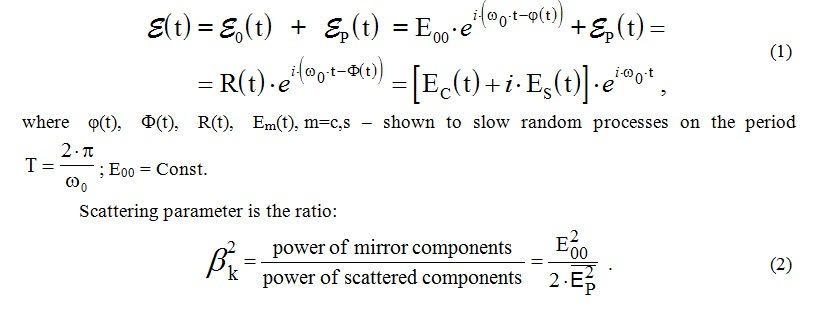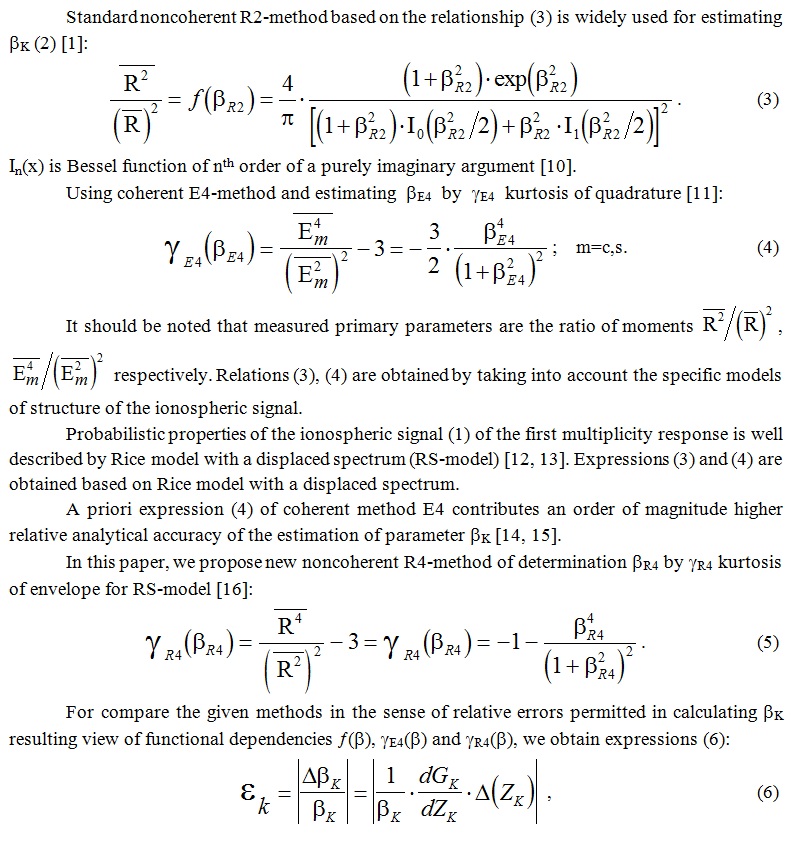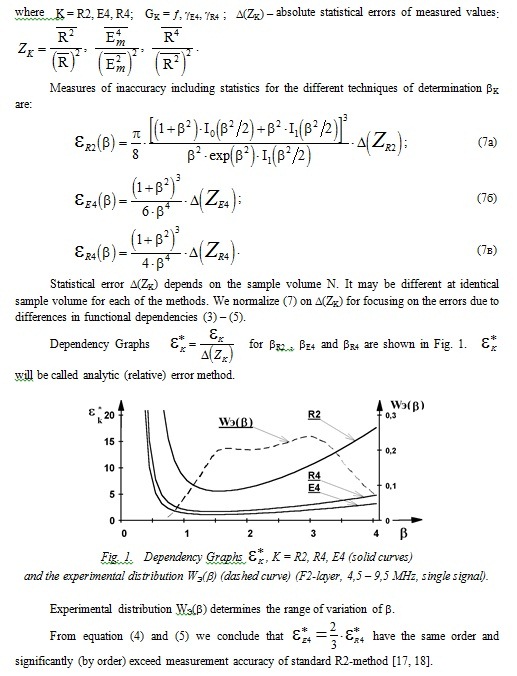BISAC NAT010000 Ecology
BISAC NAT045050 Ecosystems & Habitats / Coastal Regions & Shorelines
BISAC NAT025000 Ecosystems & Habitats / Oceans & Seas
BISAC NAT045030 Ecosystems & Habitats / Polar Regions
BISAC SCI081000 Earth Sciences / Hydrology
BISAC SCI092000 Global Warming & Climate Change
BISAC SCI020000 Life Sciences / Ecology
BISAC SCI039000 Life Sciences / Marine Biology
BISAC SOC053000 Regional Studies
BISAC TEC060000 Marine & Naval
A new method for estimating the parameter noncoherent signal/noise K of ionospheric signal is offered. A comparative analysis is carrying out. This new method exceeds an order of magnitude widely used standard one by analytical (relative) accuracy of determining a parameter K. It has the same order as the well-known coherent methodology.
remote sensing, measurement technique, the scattering parameter signal/noise ratio. vertical sounding, Earth Surface Scattering Power K.
I. Introduction
Parameter of returned partially scattered ionospheric signal bK is of interest to an important characteristic of the "perturbation" and "turbidity" of statistically inhomogeneous ionospheric plasma and to the work index of reliability of ionospheric communication channels including diagnostic one. Prompt and reliable estimate of the parameter bK is of interest to radio physics, geophysics, and optics. Specification for ionospheric case is implemented.
This range allows us to diagnose sub-surface layer of the earth because scattering parameter is formed by inhomogeneities dielectric permittivity of the subsurface structures.
The problem of measuring and accounting of scattering power of the earth's surface in the short-range radio waves is an important for solving such challenges as diagnostic properties of the environment by means of methods that use this radio band, when in the channel there is an intermediate reflection (scattering) of the earth's surface, which is of interest for exploration and environmental studies.
Selection of the working sensing range and the impact of environment on the passing radiation are an important issues for using space-based tools, for environmental management and environmental monitoring.
The most important aspects of using space-based tools for environmental management and environmental monitoring are the choice of the operating range and probing questions about the influence of media on the passing radiation [1]. The problem of this discussion is the "rough" remote diagnostics of the earth's surface and subsurface of the dielectric structures in the SW range [2]. Selection of SW range takes into account the subsurface layer (thickness of the order of the wavelength of the incident signal). Interpretation of the data is based on a statistical multiplicative model of the signal [3]. Testing the method of obtaining a signal/noise ratio in this model was produced by the example of a double reflection of the probe signal from the SW ionosphere in a vertical sounding (remember that when using a satellite, the signal passes twice through the atmosphere and ionosphere). The work addressed issues of sensitivity of the model parameters that were studied.
The measurement, mapping, and computation of the "rough" Earth Surface Scattering Power (ESSP) in the SW range are of interest for a set of problems (communication, geology, etc.). The ESSP parameter is the signal/noise ratio of the bK waves reflected from the earth’s "rough" backing. There is the back of the bK-data and measuring method is in SW range. [4] presents the experimental method of bK determination.
In this paper, this method is tested on the parameter of bK sensitivity. According to the statistical model (SM), a database ("records" for the numerical experiment) adequate to the real conditions was created. The properties of the "rough" earth area were defined by the theoretical bK value. Based on the method of [5], bK (numerical experiment) was determined. Then, the arrays of the bK and bKt were compared and analyzed. In this paper, the admissible sensitivity and stability of the method [6] were justified. The comparative analysis of the real experimental data and adequate numerical ones were fulfilled. As a result, the plausibility of the ionosphere echo statistical structures used were justified [7].
In this paper, we propose a new method for estimating the parameters of noncoherent signal/noise ratio bK ionospheric echo [8]. A comparative analysis shows that the analytical (relative) accuracy of the determination of the parameter bK using the new method exceeds the widely-used standard, and the same order of known coherent methodology [9].
The paper presents the results of comparison of the measurement method from the point of view of their admissible relative analytical errors. The new method is suggested.
II. Calculation methods
Narrowband random process E(t) in fixed point of reception in the ground in scalar approximation is the superposition of mirror E0(t) and scattered EР(t) components distributed by the normal law:

Here and below, “ — ” means statistical averaging. EC(t) = R(t)×cos F(t) and ES(t) = R(t)×sin F(t) are low-frequency quadrature of the ionospheric signal, R(t) is envelope, F(t) is total phase.
The subscript k = E4, R2, R4 means experimentally recorded primary random processes and appropriate method of their registration: E4 – coherent; R2, R4 – noncoherent amplitude. Index k indicates the primary parameter recorded: E – quadrature, R – envelope of the ionospheric signal.

Analysis of analytical error of estimation of the parameter bK allowed to recommend R4‑method instead of standard R2‑method. Sufficiently high analytical (relative) accuracy of parameter estimation bK can be achieved using noncoherent apparatus using (5) of R4‑method [19]. Naturally, the ability to optimize the statistical error by the relevant special digital processing of ionospheric signal is keep on coherent methodology E4 [20].
III. Conclusion
The comparative analysis of the normalized relative analytical errors  of the known methods and the new one was performed [9]. It was shown that errors e*E and e*R4 have the same order, and both errors significantly exceed the error e*R2 in comparison with the standard R2‑method by a measurement accuracy of bK [14].
of the known methods and the new one was performed [9]. It was shown that errors e*E and e*R4 have the same order, and both errors significantly exceed the error e*R2 in comparison with the standard R2‑method by a measurement accuracy of bK [14].

Environmental monitoring of the earth's surface by remote sensing in the short-wave band can provide quick identication of some ecological characteristics. This band range allows one to diagnose subsurface aspects of the earth, as the scattering parameter is affected by irregularities in the dielectric permittivity of subsurface structures. This method based on the organization of the monitoring probe may detect changes in these environments, for example, to assess seismic hazard and seismic risk [17]. The problem of measuring and accounting for the scattering power of the earth's surface in the short-range of radio waves is important for a number of purposes, such as diagnosing properties of the medium using the radio band when going on the road to interpret the intermediate reflection (scattering) from the earth's surface, which is of interest for geological and environmental studies [4].
As a result, it was found that sufficient bK analytical measurement accuracy can be achieved when using an noncoherent apparatus [13] using a new R4‑method. But the coherent E‑method reserves the possibility of statistical error optimization with a special processing of the ionospheric signal [20].
1. Ya.L. Alpert, “Rasprostranenie radiovoln v ionosfere.” [Distribution of radio waves in an ionosphere.] AN USSR, Moscow, 1960, 480 p.
2. S.F. Mirkotan, S.Yu. Belov, and V.I. Zaharov, “Distancionnaia diagnostika rasseivayushei sposobnosti "sherohovatoi" zemnoi poverhnosti v korotkovolnovom diapazone radiovoln.” [The distant diagnostics of the “rough” Earth Surface Scattering Power in the SW range.] // Radiotechnika i electronika, vol. 44, № 10, 1999, pp. 1190-1194.
3. S.F. Mirkotan and S.Yu. Belov, “O parametre vozmushennosti neodnorodnoi fluktuiruyushei ionosfernoi plazmy.” [On disturbance parameter of the irregular, fluctuating ionosphere.] // Radiotechnika and electronika, vol. 43, № 11, 1998, pp. 1382-1383.
4. S.Yu. Belov, “Metody otsenki parametra signal/shum v korotkovolnovom diapazone radiovoln.” [Parameter assessment methods signal/noise in the SW range of radio waves]. In Fizicheskie problemy ekologii (Ekologicheskaya fizika) [Physical Environmental Problems (Ecological Physics)], V.I. Trukhin, Yu.A. Pirogov, K.V. Pokazeev, Eds. Moscow: MAKSPress, vol. 16, 2010, pp. 31-38.
5. S.Yu. Belov, “Chislennoe modelirovanie v zadache testirovaniya metoda distancionnoi diagnostiki rasseivayushei sposobnosti zemnoi poverhnosti v KV-radiodiapazone.” [Numerical simulation test in the problem of remote diagnostics scattering power of the earth's surface in the SW range.] Proceedings of the International Youth Scientific Forum "Lomonosov-2015", A.I. Andreev, A.V. Andrianov, E.A. Antipov, Eds. [Electronic resource] Moscow: MAX Press, 2015.
6. S.Yu. Belov, “O metodah opredeleniya parametra signal/shum na primere rasprostraneniya radiosignala v kanale Zemlya - Ionosfera.” [On the methods of determining the parameters of the signal/noise ratio at the example of propagation of radio channel Earth-Ionosphere.] Proceedings of the International Youth Scientific Forum "Lomonosov-2013", A.I. Andreev, A.V. Andrianov, E.A. Antipov, M.V. Chistyakov, Eds. [Electronic resource] Moscow: MAX Press, 2013, p. 73.
7. S.Yu. Belov, “Distantsionnaia diagnostika rasseivayushei sposobnosti zemnoi poverhnosti v dekametrovom diapazone radiovoln.” [The distant diagnostics of the Earth Surface Scattering Power in the decameter radio waves]. XVI International Symposium with the Elements of Scientific School for Youth "Optics of Atmosphere and Ocean. Physics of Atmosphere." Tomsk, 2009, pp. 279-280.
8. S.Yu. Belov and I.N. Belova, “Vyyavlenie ekologicheskogo riska pri monitoringe poverhnosti zemli metodom distantsionnogo zondirovaniia v korotkovolnovom diapazone radiovoln.” [Identification of environmental risk in monitoring land surface remote sensing in the SW range]. Proceedings of the II All-Russia Scientific Conference "Ecology and Space" Academician K.Y. Kondratyev, Y. Kuleshov, Ed. Saint-Petersburg: WCA name Mozhaiskii, 2015, pp. 70-76.
9. S.Yu. Belov and I.N. Belova, “On the signal/noise ratio of the measurement method of the inhomogeneous fluctuating diffraction screen.” International Symposium «Atmospheric Radiation and Dynamics» (ISARD-2015), Saint-Petersburg, 2015, p. 104.
10. S.Yu. Belov, “Distantsionnaia diagnostika rasseivayushei sposobnosti zemnoi poverhnosti v KV-diapazone.” [The distant diagnostics of the Earth Surface Scattering Power in the SW range.] Prospects of Development of Scientific Research in the 21st Century: Proceedings of the 6th International Scientific and Practical Conference, Makhachkala, 2014, p. 43.
11. S.Yu. Belov, “New measurement method of estimation signal/noise parameter.” European Geosciences Union General Assembly 2010 Vienna, Austria, Geophysical Research Abstracts. 2010, vol. 12, p. 2233.
12. S.Yu. Belov and I.N. Belova, “Eksperimentalnaya apparatura kogerentnogo priema v zadachah monitoringa poverhnosti zemli metodom distancionnogo zondirovaniya v korotkovolnovom diapazone radiovoln.” [The experimental apparatus coherent reception in the tasks of monitoring land surface remote sensing in the short-range radio waves.] II International Conference of Young Scientists "Modern Problems of Geophysics, Engineering Seismology and Earthquake Engineering." Erevan, 2015.
13. S.Yu. Belov and I.N. Belova, “Funkcional'naya shema eksperimentalnoi apparatury kogerentnogo priema v zadachah monitoringa poverhnosti zemli metodom distancionnogo zondirovaniya v korotkovolnovom diapazone radiovoln.” [Functional diagram of the experimental apparatus coherent reception in the tasks of monitoring land surface remote sensing in the short-range radio waves.] III International scientific-practical conference "Applied aspects of geology, geophysics and geo-ecology, using modern information technology." Maikop, ISBN 978-5-906696-22-9, 2015, pp. 53-58.
14. S.Yu. Belov and I.N. Belova, “Monitoring poverhnosti zemli metodom distancionnogo zondirovaniya v KV-radiodiapazone.” [Monitoring of the Earth's surface by method of remote sensing in SW range.] // V International Youth Scientific Conference "Ecology-2015", Arkhangelsk. ISBN 978-5-91378-098-0, 2015, pp. 6-7.
15. S.Yu. Belov, “O nekotoryh harakteristikah rasseivayushei sposobnosti zemnoi poverhnosti pri distancionnom zondirovanii v korotkovolnovom diapazone radiovoln.” [On some characteristics of the scattering of the earth surface for remote sensing in the short-wave band.] II International Conference «Regional problems of remote sensing of the Earth» (RPDZZ-2015), Krasnoyarsk, E.A. Vaganov, M.V. Noskov, Eds. Sib. Feder. University Press, ISBN 978-5-7638-3306-5, 2015, pp. 101-104.
16. S.Yu. Belov, “O vozmozhnosti povysheniya tochnosti izmereniya rasseivayushei sposobnosti zemnoi poverhnosti pri distancionnom zondirovanii v korotkovolnovom diapazone radiovoln.” [About a possibility of increasing the accuracy of measurements of the Earth's surface scattering ability at remote sensing in the short-wave range of radio waves.] // 24th Scientific Conference "The structure of the substance, the history of the lithosphere Timan-Severouralsk segment", Syktyvkar, Geoprint, 2015, pp. 28-31.
17. S.Yu. Belov and I.N. Belova, “Environmental aspects of the use of remote sensing of the earth's surface in the short-wave range of radio waves.” // IGCP 610 Third Plenary Conference and Field Trip “From the Caspian to Mediterranean: Environmental Change and Human Response during the Quaternary” 22-30 September 2015, Astrakhan, Russia. A. Gilbert, V. Yanko-Hombach, T. Yanina, Eds. Moscow, MSU, 2015, pp. 29-31.
18. S.Yu. Belov and I.N. Belova, “On the possibility of more informative methods of determining the parameters of the signal/noise ratio at the example of propagation of radio short-wave radio waves.” // XVII Scientific School "Nonlinear Waves 2016", A.V. Slyunyaev, Ed. Nizhny Novgorod, 2016, p. 170.
19. S.Yu. Belov, “Kogerentnyy i nekogerentnyy metody opredeleniya parametra signal/shum v zadachakh rasprostraneniya radiosignala korotkovolnovogo diapazona radiovoln.” [Coherent and incoherent methods of determining of the parameter signal/noise in problems of propagation of radio waves of the short-wave range.] // XXIII International conference of students, graduate students and young scientists on fundamental sciences "Lomonosov-2016", vol. Moscow, MSU. ISBN 978-5-8279-0127-3. 2016, pp. 171-173.
20. S.Yu. Belov, “Programma registracii kvadraturnyh komponent n-kratnogo otrazhennogo ot zemnoi poverhnosti radiosignala.” [The program of registration quadrature a component of the n-fold reflected radio signal from a terrestrial surface.] The certificate on registration of the right to the software No. RU.2016612172 of 19.02.2016.







